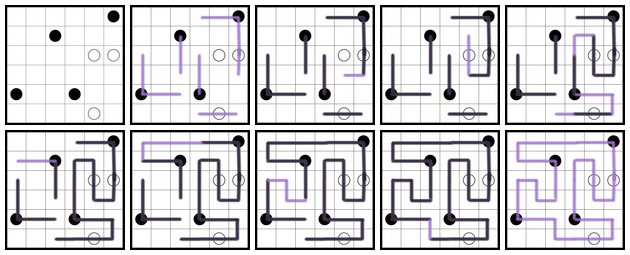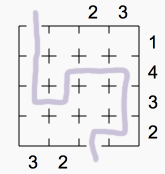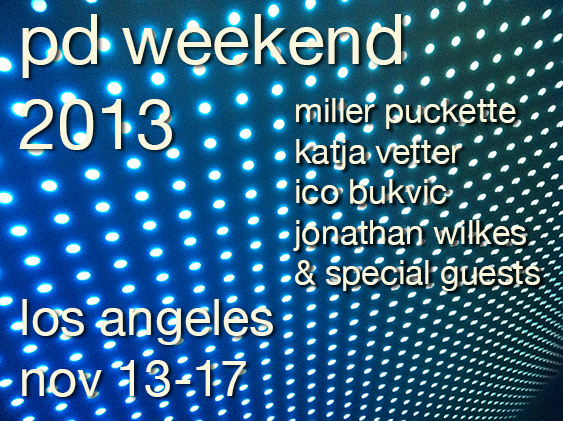July 13th, 2014
While grocery shopping this evening, I happened to notice a box of Kraft Mac & Cheese that was turned around, with a familiar looking maze on the back.

While this maze may look generic to you, it looks quite recognizable to me, because I spent quite a bit of time writing software that produces mazes in this style. If you look closely, you may notice the vertices form a fibonacci spiral. It’s a pretty unique design, but, just to be sure, I bought a box, took it home, and started looking through the collection of mazes on my website. These mazes are free for you to download, but definitely not free for you to reuse, unless I grant you permission.
Looking at my website, I found the original pretty quickly. The artist took Maze #1 from Book #1 (published in 2010) of my Intermediate Mazes, and turned it 90 degrees clockwise, and altered it in a handful of spots. Despite the addition and removal of about 7 line segments, the majority of the puzzle is identical to the original. Alas, he or she forgot to ask permission to use my design! They also failed to notice my copyright notice. I can only assume that they figured I wasn’t a consumer of Kraft Macaroni & cheese, or that I would never touch the SpongeBob variety that this maze appeared on (true – I prefer the classic elbow variety, which is getting increasingly hard to find for some reason). I admit I’m not terribly proud of my biannual craving for classic Kraft Mac, but sometimes, I like to pretend I’m 8 years old again.
Here’s the two mazes side by side, just in case there was any doubt:

A helpful note to the good folks at Kraft Foods, or any other multinational conglomerates that wish to use my content without my permission: If you’re gonna steal a maze, you might want to try stealing from maze book #47, and do a horizontal swap on it before you rotate it 90 degrees. That’ll slow me down some…
UPDATE: I’ve worked things out. The story continues…
Permalink | 13 Comments »
June 23rd, 2014
 For the past several days I’ve been enjoying solving successive levels of Euclid the Game, an online set of puzzles based on Euclid’s Elements. For the past several days I’ve been enjoying solving successive levels of Euclid the Game, an online set of puzzles based on Euclid’s Elements.
You are initially given the equivalent of a stick, a straight edge and a compass (tools for drawing points, lines and circles), and are asked to construct an equilateral triangle. Once you’ve solved that, you now have a new tool that draws equilateral triangles, which you use to help solve the next problem. As you solve successive problems, you build up a collection of increasingly sophisticated tools, and solve increasingly difficult problems.
I’m currently on level 20. Not sure how far this goes, but let me know if you get stuck.
Permalink | 2 Comments »
May 11th, 2014
This is a new demonstration I’ve prepared of my Mirror Morph technique, discussed previously. It’s a simple 2D trick that can make still images look three dimensional.
Here’s a GIF version.

Permalink | Comments Off on Benjamin Franklin “Holograph”
May 9th, 2014

I occasionally get requests to add new puzzle varieties to the collection. I have to ignore a lot of these, because there are 24 hours in a day. However, the last request I received, for Masyu puzzles, was hard to ignore, since I’ve enjoyed solving these myself for the past few years, and I’d love to have access to a larger collection of them. So what the heck! I made a bunch.
Masyu puzzles are closely related to Slitherlink and other spatial reasoning puzzles. Like Slitherlink, the end result is a loop which is constructed from straight line segments.
Unlike Slitherlink, Masyu puzzles don’t use numbered clues. Instead, the clues are black and white circles, which I am told resemble pearls (although I think they resemble the stones in the board game Go). This gives the puzzles an elegant simplicity which is perhaps only rivaled by Galaxy puzzles, another great Nikoli-style puzzle.
Masyu puzzles use the following rules:
- Black circles indicate corners.
- White circles indicate straights.
- Black circles must be turned upon, but the loop must travel straight through the next and previous cells in its path.
- White circles must be traveled straight through, but the loop must turn in the previous and/or next cell in its path.
If you’d like to learn more about how to solve the puzzles, I’ve written a (hopefully) helpful tutorial, which you’ll find here. If you find the tutorial less-than-helpful, let me know, so I can work to improve it.
If you’re ready to try your hand at these puzzles, check ’em out!.
Permalink | Comments Off on Masyu puzzles are here!
April 24th, 2014
Permalink | Comments Off on BaffleDazzle – an interesting kickstarter for puzzle people
April 18th, 2014
Permalink | Comments Off on Cool music visualizer with flames
February 8th, 2014
 Roderick Kimball wrote to tell me about an interesting logic puzzle he’s developed called Path Puzzles. Roderick Kimball wrote to tell me about an interesting logic puzzle he’s developed called Path Puzzles.
In these puzzles, you must make a path that winds its way from one opening to another on the edge of the grid. The clue numbers tell you how many squares in each row or column are occupied by the path.
The more advanced versions of the puzzles involve more ambiguous clues, and multiple door choices; which makes them significantly more challenging.
If you’d like to try these puzzles out, check out this sample page that Roderick has provided to Krazydad readers:
Path Puzzles Sample Page
Want some more? Go to pathpuzzles.com.
And happy puzzling!
Permalink | Comments Off on Path Puzzles
December 5th, 2013
 Emergent Orange describes the orange hue that is produced when you average together a bunch of randomly selected digital photographs. Emergent Orange describes the orange hue that is produced when you average together a bunch of randomly selected digital photographs.
The illustration shows 5 different sets of photos (randomly selected from Flickr) accumulating over successive rows. The first row is a single image. Then 2 images, 5 images, 25 images, and 100 images in the bottom row. I have cranked up the saturation to reveal the orange shift (unprocessed averages tend to look like dirt or milk-chocolate).
I stumbled across this effect in 2006, playing with Flickr, and have blogged about it a few times. Other digital artists who use the same averaging technique have also observed the effect. The reasons why it happens are not yet entirely clear, but I suspect it has something to do with chemistry and physics. Interestingly the same effect occurs with collections of human-generated synthetic, abstract art (not photos), such as fractals.
Over thanksgiving break I wrote an informal paper describing my findings to date, in hopes of attracting some brighter minds to the topic. Perhaps you are one of those minds? You’ll find my paper here.
If you prefer pretty pictures to words, here’s a Flickr set containing some of my image averaging experiments.
Permalink | 4 Comments »
November 7th, 2013

PD Weekend is an upcoming series of events at CRASHspace in Culver City revolving around electronic music and art made using PureData, it’s commercial sibling MAX/MSP and other tools. The creator of both of the aforementioned applications, Miller Puckette will be on hand to teach a Raspberry PI + PD seminar. There will be a number of other great classes covering topics such as Live Sampling, Laptop Orchestration, and Creativity.
The events run from November 13th, through 17th, with most of the events on Saturday and Sunday.
Saturday evening there will be a lovely concert of Handmade Music, and on Sunday afternoon there will be the monthly PD Patching Circle – a great free event where you can hang out with other handmade music enthusiasts, and work on your projects.

At the Saturday evening concert, I’ll be demonstrating a new-improved version of my astronomical-music-clock Wheel of Stars (I’m tarting it up right now…).
Hope to see you there!
Permalink | Comments Off on PD Weekend / Handmade Music 2013
August 8th, 2013

An interesting puzzle, basically a kind of maze with limited movements, that resembles a crossword, by Tyler Capp.
Link.
Permalink | Comments Off on Not a crossword
|
|










